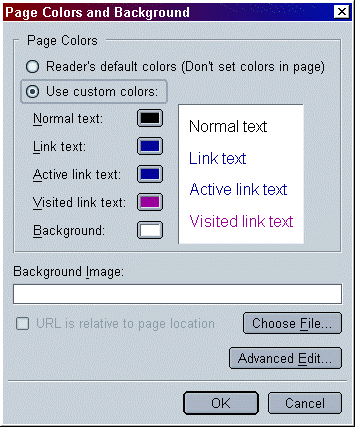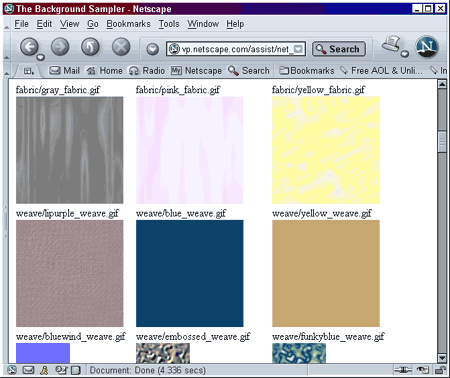
Netscape Composer 7
Adding a Background Color or Texture/Image to a Web Page
Use Composer's Page (Colors and) Properties feature to add a background color or texture/image to your Web page.
Note: The screen images included in this document are taken from the Windows version of Netscape Composer. Macintosh screens may differ slightly.
Specifying a Background Color
To specify a background color for your page, first, from the Format menu choose (click) Page Colors and Background. Then, in the "Page Colors and Background" dialog box, click Use Custom Colors and make your selection(s) (see Figure 1, below). The preview area in the dialog box shows how your selection(s) will look on your Web page. When finished, click the OK button.FIGURE 1. Page Colors and
Background Dialog Box

If you do not specify colors yourself, the colors displayed when someone views your Web page will be the colors selected by that person. If the person has made no selections, the browser's default display colors will be used.
Adding
a Background Texture
(or Other Background Image)
When you see
a textured background on a Web page, you are looking at a repeated image
that happens to be a texture rather than a picture or symbol (such as a
logo). To use something other than a solid background color, you must specify
an image source file. This document includes instructions for downloading
a free background image from a website. It does not include instructions
for creating your own images (using a graphics program like PhotoShop, for
example).
Background Image Files
The two file formats commonly used (and recognized!) on the Web are GIF (.gif) and JPEG (.jpg). Generally speaking, GIF files are most suitable for black & white images or line drawings — or other images containing a maximum of 256 colors. JPEG files are best for photographs (the file size is smaller and there is full-color support — i.e., 16.7 million colors).There is a background sampler page on Netscape's website from which you can download background textures free of charge. Alternatively, you can use the Search feature to find other "free backgrounds". Once you find a background you want to use, it is a good idea to copy (download) it, and then publish the background along with the page itself to your account on CSUN's Web server. Netscape allows you to use its backgrounds directly from the Netscape server, but other sites will tell you to download what you want to use.
To download a background image file from Netscape (or some other site), do the following.
- Go to
the site from which you wish to download an image file, such as http://wp.netscape.com/assist/net_sites/bg/backgrounds.html
(see Figure 2, below).
FIGURE 2. Some Textures Available from Netscape's Background Sampler Page

- Position the mouse pointer over the image you want to copy.
- Access the context-sensitive pop-up menu as follows:
- On a Windows computer, click the right mouse button.
- On a Macintosh, hold down the mouse button until the menu appears (about one second).
- Choose Save Image As... (Windows) or Save this image as... (Macintosh).
- In the "Save As" dialog box, choose the folder where you want to save the file. For the purposes of these instructions, this should be the same folder where you save your Web page (HTML) files.
- Click the Save button to save the file.
Specifying a Background Texture/Image
To specify a background image for your page, first, from the Format menu choose (click) Page Colors and Background. Then, in the "Page Colors and Background" dialog box, click the Choose File button to locate and select the desired background image file. You may need to change text color selections to complement the background chosen (see Figure 1, above). It is also a good idea to select a background color that is "similar" to your texture. That way, if the background doesn't display for some reason, the overall "look" will still be okay (text and links visible, etc.). When finished, click the OK button.Publishing Notes:
- If your Web page file and your background image file are saved in the same folder (as suggested above), the background image file will be transferred (uploaded) automatically when you publish your page.
- There is a box that can be checked if you want to "Leave image at the original location" (i.e., somewhere out there on the Web). However, as stated above, it is generally preferable to save your own copy of a background image to publish with your Web page(s).
August 14, 2003
Prepared by Gail Said Johnson, User Support Services
ITR's technology training guides are the property of California State University, Northridge. They are intended for non-profit educational use only. Please do not use this material without citing the source.